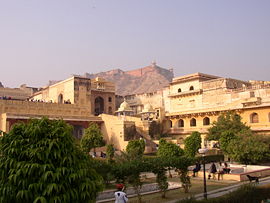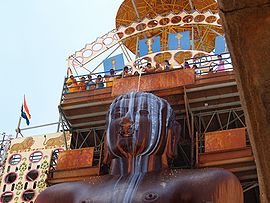- Digambar Terapanth
-
Jainism
This article is part of a series on JainismPrayers and Vows Ṇamōkāra mantra · Ahimsa · Brahmacharya · Satya · Nirvana · Asteya · Aparigraha · Anekantavada · Parasparopagraho Jīvānām Key concepts Kevalajñāna · Cosmology · Samsara · Karma · Dharma · Moksha · Gunasthana · Navatattva Major figures The 24 Tirthankaras · Rishabha · Mahavira · Acharya · Ganadhara · Siddhasena Divakara · Haribhadra Jainism by region India · Europe · United States · Canada Sects Śvētāmbara · Digambara · Svetambar Terapanth · Sthānakavāsī · Bhattaraka · Murtipujaka Texts Kalpa Sūtra · Āgama · Tattvartha Sutra · Sanmatti Prakaran Other Festivals Paryushana · Diwali
Jainism Portal
The Adhyatma movement among the Jains arose in 1626 AD (1683 in the Vikram Samvat calendar) in Agra. Its leading proponent was Banarasidas of Agra.[1] Adhyatma groups flourished during 1644-1726 in Agra, Lahore and Multan. While the movement was based on the books written by Acharya Kundakunda, most of its followers were of Shwetambar sect. It represents an interaction of the Digambara and Shwetambar sects. Later it indirectly influenced the emergence of Terapanth. Poet Dyanatrai was associated with the Adhyatma movement.
The Bispanthi/Terapanthi divisions among the Digambara Jains emerged in 17th century in Jaipur region (Sanganer, Amber and Jaipur itself).[2]
Terapanth was founded by Amra Bhaunsa Godika and his son Jodhraj Godika during 1664-1667, who were prominent citizens in Sanganer, who expressed opposition to the Bhattaraka Narendrakirti of Amber. Authors Daulatram Kasliwal [3] and Pandit Todarmal (author of Moksh Marg Prakashak [4]) were associated with the Terapanth movement.
The Digambra Terapanth movement was against the domination of the Bhattarakas. They opposed worship of various minor gods and goddesses. Some Terapanthi practices, like not using flowers in worship, gradually spread throughout North India among the Digambaras.
The Digambara Jains who have continued to follow older practices are termed Bis-panthi. Most Digambar Jains do not identify themselves as being exclusively Terapanthi or Bispanthi.
Bakhtaram in his "Mithyatva Khandan Natak" (1764) mentions that group that started it included 13 individuals, who collectively built a new temple, thus giving it its name Tera (13) Panth. However according to "Kavitta Terapanth kau" by an unknown Chanda Kavi, the movement was named Tera Panth, becuae the founders disagreed with the Bhattaraka on 13 points. A letter of 1692 from Tera Panthis at Kama to those at Sanganer mentions 13 rituals practices rejected.
The Terapanthis reject these practices:
Mentioned in Buddhivilas (1770) of Bakhtaram:
- Authority of Bhattarakas
- Use of flowers, cooked food or lamps
- Abhisheka (panchamrita)
- consecretation of images without supervision by the representatives of Bhattarakas.
The letter by Tera Panthis at Kama also mentions:
- Puja while seated
- Puja at night
- Using drums in the temple
Terapanth Khandan of Pandit Pannalal also mentions:
- Worship of minor gods like dikpalas, shasan devis (Padmavati etc.) and Kshetrapal.
In 20th century, the people who led the movement are:
1. Srimad Rajchandra, who started Shrut Prabhavak Mandal. The Mandal was responsible for translating a lot of Digambar Jain Scriptures in modern indian languages. He also wrote many poems and proses and refers the "Terapanth Digambar" as "Mool Maarag" ( The Root cause of Liberation) in his work.
2. Kanji Swami
3. Champaben, Chief disciple of Kanji Swami.
4. Shantaben, Chief disciple of Kanji Swami.
5. Pandit Himmatlal Jethalal Shah, who translated Samaysar, Pravachansar, Panchastikay and Niyamsar Scriptures into Gujarati Language in Prose form as well as Poetic form.
6. Brahmachari Pandit Vrajlal Girdhrlal Shah, who translated Purusharth Siddhi Upai and Dravya Sangrah into Gujarati Language.
7. Pandit Hukumchand Bharril, who started Todarmal Smarak Trust, and was instrumental in translation and study of many Digambar Jain Scriptures.
See also
- Terapanth for other use of the term
- Kanji Swami
References
- ^ Ardha kathanaka: Half a tale, Mukunda Lath, Rajasthan Prakrit Bharati, 1981
- ^ John E. Cort "A Tale of Two Cities: On the Origins of Digambara Sectarianism in North India." L. A. Babb, V. Joshi, and M. W. Meister (eds.), Multiple Histories: Culture and Society in the Study of Rajasthan, 39-83. Jaipur: Rawat, 2002.
- ^ http://www.jainuniverse.com/AgamTimeLog.html Time log of Great Jain Shastras
- ^ http://www.atmadharma.com/shastras/mokshmargprakashak_eng_txt/index.html The Illuminator of the Path of Liberation) By Acharyakalp Pt. Todamalji, Jaipur
Categories:- Jain sects
Wikimedia Foundation. 2010.



